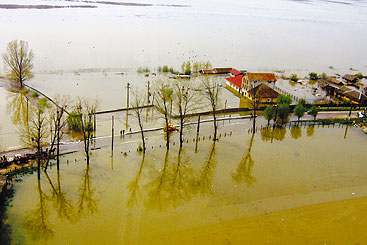Protecting the Danube from flooding
ICPDR Danube Watch: New EU members bring their own sea: good news or bad?

Protecting the Danube from flooding
Cooperation is vital to improve flood risk management in the Danube River Basin. A new Danube Flood Risk Project, initiated under the Romanian ICPDR Presidency, is working to bring collaborative mitigation methods to the Danube region.

Flood risk increases with ongoing climate change. Risk reduction can only be achieved through transnational, interdisciplinary and stakeholderoriented approaches.
Any future-oriented risk management strategy
needs joint methods, databases, and a combined
approach on assessing and coping with risk. To implement
this combination of measures, upstream
and downstream regions have to cooperate on
transboundary issues. The proposed Danube flood
Risk Project will combine top-down and bottom-up
approaches to focus on the most cost-effective
measures for flood mitigation: risk assessment,
risk mapping and risk reduction by adequate spatial
planning.
All the countries along the Danube have separated models and their own methods for flood prevention not to mention different priorities for mitigation measures. However, many regions suffer from lack of risk information for planners, population and decision makers. The Danube Flood Risk Project will bring together scientists, public servants, NGOs and stakeholders to jointly develop a scalable system of flood risk maps for the Danube. This will result in proposals for flood mitigation measures, the adjustment of spatial development plans, assessment tools for economic development in flood plains and raised awareness of flood risk in decision makers, politicians, planners and the public. In addition, this project will also help local administrations tackle their own specific flooding challenges.
Industries at risk like power
stations and supply
infrastructure will play a
key role in the project. Pilot
areas include flood risk in
large cities (Vienna, Austria),
planning high risk industrial
platforms (Kozloduy Nuclear
Power Plants in Bulgaria),
harbour sites, a large port
and naval constructor (Galati,
Romania) and other smaller
localities in prone areas.
Success is possible only through joint efforts. This project will involve all relevant organisations to guarantee political implementation. Partners for the project include national and regional authorities responsible for environment, water management and spatial planning, non-governmental organisations and research institutions. Observers from Germany, the Czech Republic and the ICPDR will provide experience with similar approaches. A bonus generated by this partnership is that all these organisations work on flood risk mitigation measures but none would be able to harmonise an approach alone.
Physical measures for flood risk mitigation are comparatively ineffective unless integrated. The most cost-effective approach is cooperation in the fields of information, mitigation and flood risk.





